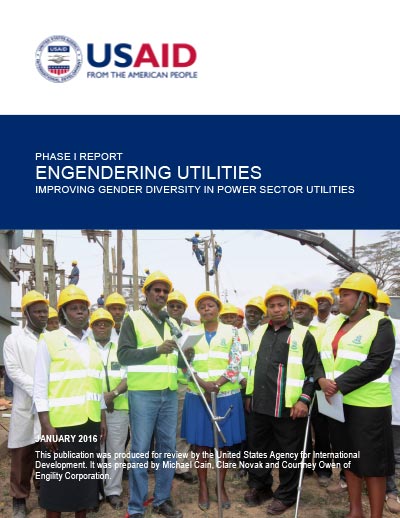- Energy Home
- How We Work
- Programs & Initiatives
- EmPOWERing Women and Girls
- Competitive Energy Procurement
- Toolkits
- Monitoring & Evaluation
- Resources
- Stories
Speeches Shim
Engendering Utilities Program Phase I Report
The initial phase of the Engendering Utilities program included a first-of-its-kind study to examine the role of women and gender disparities within electric power distribution companies. The data showed wide variation in employment practices and outcomes and suggested that women were excluded from the majority of jobs within electric power distribution companies. The findings illustrated inequalities in employment outcomes and disparities in the way utilities run their businesses, both of which ultimately impact women’s ability to fully participate in the energy sector.
Conducting Groundbreaking Research on Gender Disparity in the Energy Sector
The first phase of USAID’s Engendering Utilities program focused on improving information about and knowledge of gender equality in power sector utilities at the distribution level. As you will read in the report, the research phase of the program helped USAID better understand how electricity utilities can increase the labor market participation of women in the energy sector. Our goals were to better understand where women work, where they are not working, why they are not working there, and could they be working there.
The research goal of this report is to improve our knowledge of gender equality in power distribution companies (DISCOs) through an empirical study of labor practices in a sample of utilities throughout the world. This report is part of a USAID’s Engendering Utilities program to support better understanding of how improved gender equality outcomes can contribute to better business practices and improved operations in utilities.
The study also revealed that women work in diverse jobs at all management levels, alongside men who are their counterparts within utility companies. Jobs traditionally staffed by men in one utility may be held by women at another utility, and jobs traditionally staffed by women may be held by men elsewhere. These findings not only illustrate gender diversity of employment within utility companies, but also suggest that interventions designed to improve gender diversity must be carefully tailored to the circumstances of individual companies. Our preliminary findings suggest there is no “one size fits all” solution: HR and/or gender specialists need to gather specific data on employment and information on energy sector and HR practices to formulate successful interventions to improve gender outcomes.


Comment
Make a general inquiry or suggest an improvement.